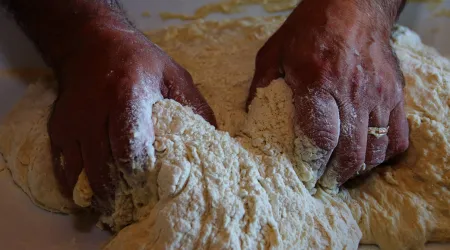How to make Neapolitan pizza at home

There Neapolitan pizza It's much more than a dish: it's a symbol of tradition, a warm embrace of Italian cuisine that combines simplicity and refinement.
Announcements
For novice chefs, the idea of recreating this masterpiece at home may seem intimidating, but with the right tricks and a pinch of passion, the result can be extraordinary.
This article will guide you step by step, with practical techniques and tips designed for those approaching this iconic recipe for the first time.
You don't have to be a chef to create a soft dough, a crispy crust, and a flavor reminiscent of Neapolitan pizzerias.
Get ready to discover how to transform your kitchen into a corner of Campania, overcoming common pitfalls and discovering the pleasure of creating something authentic with your own hands.
Announcements
Why Neapolitan pizza is special

Neapolitan pizza is distinguished by its simplicity and meticulous choice of ingredients.
The traditional recipe, recognized as an Intangible Cultural Heritage by UNESCO since 2017, follows precise rules defined by the Associazione Verace Pizza Napoletana (AVPN).
However, for beginners, it's not about chasing absolute perfection, but about understanding what makes this dish unique: a hydrated dough, quick cooking at high temperatures, and a balance between crunchiness and softness.
The main challenge for home cooks is replicating these characteristics without professional equipment, but with a few tricks and patience, the result can be surprising.
One of the most fascinating aspects is the edge, or “cornicione”, which must be high, soft and slightly burnt.
This effect, known as "leopard print," is a sign of proper cooking. Furthermore, the flavor must be balanced: the sweetness of the tomato, the creaminess of the mozzarella, and the fragrance of the basil must coexist without overpowering each other.
For beginners, the secret is to keep it simple: a few quality ingredients make all the difference.
+ Learn how to make a classic tiramisu without complications.
The ingredients: quality first and foremost
To make an authentic Neapolitan pizza, choosing the right ingredients is crucial. Here's what you'll need for two pizzas about 30 cm in diameter:
- FlourUse type 0 or 00 flour with a medium strength (220-260 W). Specially formulated pizza flour, such as Caputo Nuvola, is ideal for a light, airy dough. Avoid overly weak flours, such as those used for cakes, which cannot withstand long rising times.
- WaterfallIt should be at room temperature (about 20-22°C). Water that's too cold or too hot can slow or speed up the rising process.
- YeastFor an 8-12 hour rise, use 1-2 g of fresh yeast (or 0.5 g of dry yeast). Beginners can start with fresh yeast, which is easier to measure.
- Salt10 g of fine sea salt per 500 g of flour. Do not use iodized salt, which can alter the flavor.
- TomatoChoose peeled San Marzano tomatoes, hand-blended for a slightly rustic texture. A 400g pack is enough for two pizzas.
- MozzarellaMozzarella di bufala campana DOP is traditional, but fior di latte is an excellent alternative for those who prefer a milder flavor. Use about 100-120 g per pizza.
- Basil: A few fresh leaves, added after cooking to preserve its aroma.
- Extra virgin olive oil: A drizzle of raw ham to enhance the flavours.
A common mistake among beginners is to use low-quality ingredients thinking that “it's just pizza anyway”.
Neapolitan pizza is all about the details: a sour tomato or a mozzarella that releases too much liquid can compromise the result.
Essential tools to get started

You don't need a wood-fired oven to get good results, although it's ideal. Here are the tools that will help you:
- Domestic oven: Set the temperature to the highest setting (usually 250-300°C). A baking stone or steel pan (such as a Baking Steel) improves cooking, simulating the intense heat of a professional oven.
- Pizza peelA wooden or metal peel makes it easier to transfer the pizza to the oven.
- Large bowl: To knead and let rise.
- Precision scale: Essential for measuring flour and yeast precisely.
- Baking tray or work surface: To roll out the dough without it sticking.
A handy tip: If you don't have a baking stone, invert a heavy metal baking sheet and preheat it in the oven. This works surprisingly well for creating a crispy crust.
How to Make Neapolitan Pizza: The Key Steps
Here's a step-by-step guide to making the perfect Neapolitan pizza, designed for those who don't have much cooking experience:
Prepare the dough
In a bowl, dissolve 1 g of yeast in 300 ml of water. Gradually add 500 g of flour, mixing with a spoon or your hands.
When the dough begins to form, add 10 g of salt and continue kneading for about 10 minutes, until it becomes smooth and elastic.
For beginners, it helps to work on a floured surface to prevent the dough from sticking.
Neapolitan pizza dough is hydrated (about 60% water to flour), so it will be slightly sticky: resist the temptation to add extra flour.
Leavening
Cover the dough with a damp cloth or cling film and leave it to rest at room temperature (22-25°C) for 8-12 hours.
After about 6 hours, divide the dough into two loaves of 250-270 g each and let them rest for another 2-3 hours.
Here's a trick to check if it's ready: lightly press a block of dough with your finger; if the imprint springs back slowly, it's perfect.
Prepare the dressing
Blend the San Marzano tomatoes with a pinch of salt. Don't cook them: the fresh flavor is essential. Dice the mozzarella and let it drain in a colander to prevent it from releasing too much water during cooking.
Roll out the dough
On a lightly floured surface, gently press the dough from the center outwards, leaving a 1-2 cm border.
Don't use a rolling pin: Neapolitan pizza is rolled out by hand to preserve air in the dough. The disc should be thin in the center (about 3 mm) and thicker at the edges.
Season
Spread 80-100 g of tomato sauce over the disc, leaving the edges free. Add 100 g of mozzarella, evenly distributed, and a drizzle of extra virgin olive oil.
Don't overdo it: too many ingredients make the pizza heavy and difficult to cook.
Cook
Preheat the oven to 250°C (or higher, if possible) with a pizza stone for at least 45 minutes. Transfer the pizza to the stone using a peel or a baking sheet.
Bake for 10-12 minutes, until the crust is golden brown with a few dark spots. If your oven isn't high enough, bake for 2 minutes longer, checking to see if the base is crispy.
Finish
Add 2-3 fresh basil leaves and another drizzle of raw olive oil. Serve immediately.
Overcoming common difficulties
Beginners often encounter problems like overly sticky dough, a soft base, or an unbalanced flavor. Here's how to avoid them:
- Sticky dough: Use less water the first time (280 ml instead of 300 ml) and work with lightly floured hands.
- Soft baseMake sure the stone is very hot and don't over-toss. An overloaded pizza won't cook evenly.
- Flat flavorChoose fresh, quality ingredients. A bland tomato or watery mozzarella can ruin everything.
- Flat cornice: Don't press the edges while rolling out the dough and let the loaves rise long enough.
An interesting fact: according to a 2023 study by the University of Naples, long leavening (at least 8 hours) not only improves digestibility, but also enhances flavor, thanks to the slow fermentation of sugars in the flour.
This is a plus for home cooks, as it doesn't require any sophisticated equipment, just time.
Trends and innovations for beginners
In recent years, homemade Neapolitan pizza has become a true global passion.
According to a report by Red Shrimp By 2024, sales of compact home baking stones and ovens, such as the Ooni or Roccbox, increased by 30% in Europe.
These tools make it easier to reach high temperatures (up to 450°C), ideal for quick cooking.
However, even without investing in expensive equipment, you can achieve great results with a quality pan and a little practice.
Another trend is the focus on sustainability: many amateur pizza makers choose organic or local flours to reduce their environmental impact.
For beginners, this can be an opportunity to explore artisanal mills or local markets, discovering new flavors and supporting small producers.
Conclusion: your Neapolitan pizza awaits you
Prepare a Neapolitan pizza at home it is a journey that combines technique, patience and creativity.
Don't be discouraged by initial difficulties: every pizza you bake is a step towards mastering this art. Start with simple ingredients, follow the steps carefully, and don't be afraid to experiment.
The satisfaction of seeing your crust puffed up and golden, of smelling the fresh basil and of savoring a perfectly balanced bite will repay every effort.
Grab a bowl, weigh out the flour, and turn on the oven: today is the perfect day to make your first Neapolitan pizza.
And who knows, maybe soon you'll be teaching your friends the secrets of perfect dough. Good luck and happy pizza!
